The global microalgae market is likely to reach USD 29.6 billion by 2035, reflecting a CAGR of 8.0%. The market is valued at USD 13.7 billion in 2025. Factors driving this growth include rising demand for natural, sustainable ingredients across the food, pet care, and cosmetics industries, along with technological advances in photobioreactor systems.
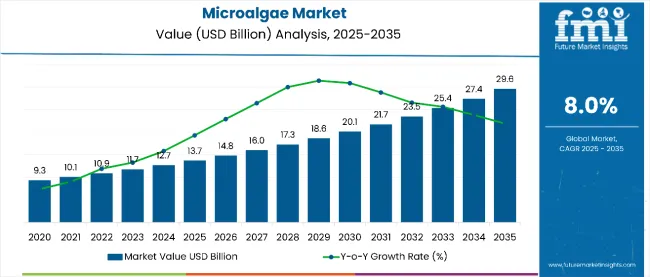
| Metric | Value |
|---|---|
| Estimated Size (2025E) | USD 13.7 billion |
| Projected Value (2035F) | USD 29.6 billion |
| CAGR (2025 to 2035) | 8.0% |
The expanding application scope in bioplastics, nutraceuticals, and fermented algae-based fuels is also anticipated to create lucrative opportunities during the forecast period.
The USA is expected to lead the global microalgae market with the largest market share in 2025, growing at a significant CAGR of 8.2%. Meanwhile, France and Japan are anticipated to register the fastest growth with CAGRs of 5.2% and 5.1% respectively. Spirulina is projected to dominate the species segment with a 38% market share, followed by Chlorella. The marine water source segment is expected to lead with a 45% share in 2025, owing to the ease of cultivation and minimal land use.
The market holds a significant share across several broader sectors due to its diverse applications. It accounts for approximately 18% of the overall seaweed and algae market, driven by its higher commercial value and versatility. Within the functional ingredients market, it contributes around 6%, owing to its rising use in food, beverages, and cosmetics.
In the nutraceuticals market, microalgae represent nearly 8%, fueled by growing demand for natural supplements. It also holds about 5% share in the alternative protein market and roughly 3% in the renewable energy market, mainly due to its emerging role in algae-based biofuels.
Going forward, the microalgae market is anticipated to benefit from increased government funding for clean energy and water treatment technologies. Recent innovations include algae-derived heme for plant-based meat and biodegradable plastics. Supportive regulations encouraging sustainable farming and renewable ingredients are also expected to accelerate commercialization.
Key universities and startups are entering the market with R&D in algae cultivation, bioremediation, and nutraceutical applications. Further, government support for eco-friendly energy solutions and initiatives for wastewater treatment using microalgae is expected to boost adoption.
The market is segmented into species, source, application, and region. Under species, the key categories include spirulina, chlorella, dunaliella, haematococcus, crypthecodinium, schizochytrium, euglena, nannochloropsis, phaedactylum, and others (including ankistrodesmus, tetraselmis, and tsochrysis).
In terms of source, the market is divided into Marine Water and Fresh Water. Application-wise, it includes food and beverages sector, health and medical sector, animal feed sector, pet food sector, cosmetics and personal care sector, and fertilizers sector. Geographically, the market spans North America, Latin America, Europe, Asia Pacific, and the Middle East & Africa (MEA).
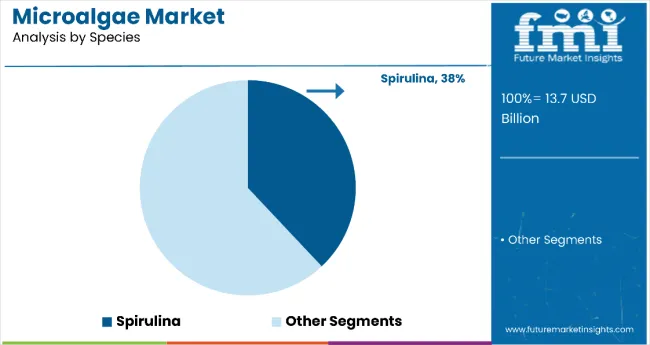
Spirulina is projected to dominate the species segment with a 38% share in 2025, owing to its high protein content and increasing usage in dietary supplements, functional beverages, and health food products. Its antioxidant and anti-inflammatory benefits have led to wider acceptance in the nutraceutical and personal care sectors.
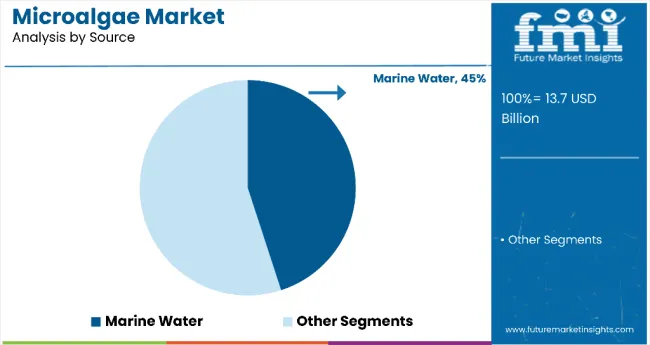
Marine water microalgae are estimated to hold a 45% market share in 2025, driven by their ability to grow on non-arable land and without freshwater resources. This segment is highly favored due to low cultivation cost and minimal environmental impact. Marine algae like Nannochloropsis and Dunaliella are particularly rich in Omega-3s and carotenoids, making them valuable for health and feed applications.
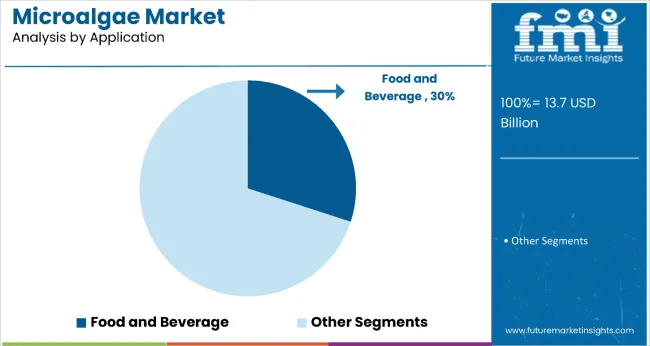
The food and beverages sector is set to lead with a 30% share in 2025, as manufacturers increasingly use microalgae for fortification, color, and taste enhancement. From energy bars to dairy alternatives and plant-based meat, algae are now present in multiple mainstream formats. Their nutritional richness and natural sourcing make them popular among vegan and health-conscious consumers.
Recent Trends in the Microalgae Market
Key Challenges in the Microalgae Market
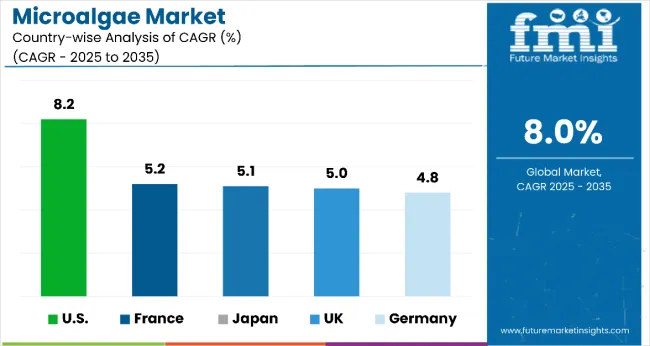
Among the top five countries in the market, the USA leads with the highest projected CAGR of 8.2% from 2025 to 2035, driven by strong investments in sustainable fuels and nutraceuticals. France follows at 5.2%, supported by its robust food sector and agricultural applications. Japan and the UK both record stable growth at CAGRs of 5.1% and 5.0%, fueled by clean energy transitions and algae-based health products.
Germany is anticipated to grow at 4.8%, benefiting from academic-industry partnerships and the expansion of algae-based cosmetics. Overall, North America is set to outpace Europe and Asia in terms of growth momentum in microalgae production and consumption.
The report covers an in-depth analysis of 40+ countries; five top-performing OECD countries are highlighted below.
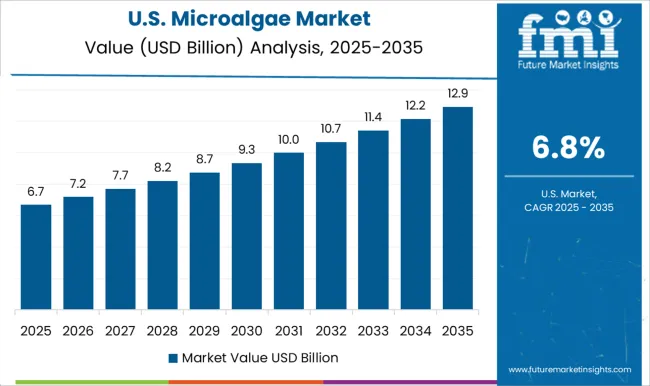
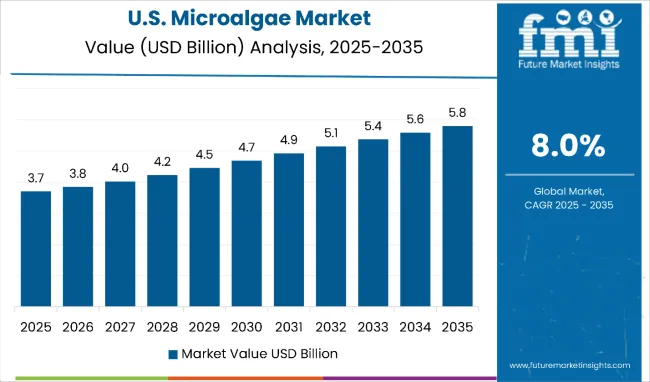
The microalgae revenue in the USA is expected to expand at a CAGR of 8.2% from 2025 to 2035. Growth is primarily driven by advanced applications in aerospace and sustainable fuel initiatives, as well as a strong focus on nutraceuticals and functional foods. Regulatory support for algae-based aviation fuels and the growing preference for algae-derived ingredients in cosmetics and supplements are key contributors to the expanding market.
The microalgae market in the UK is forecast to grow at a CAGR of 5.0% between 2025 and 2035. Growth is supported by strong academic-industry collaboration, especially in industrial biotechnology. Programs like Algae-UK are enhancing the development of sustainable algae-based solutions. Companies are using microalgae in everything from biofertilizers to functional beverages, creating new avenues for domestic and export-oriented production.
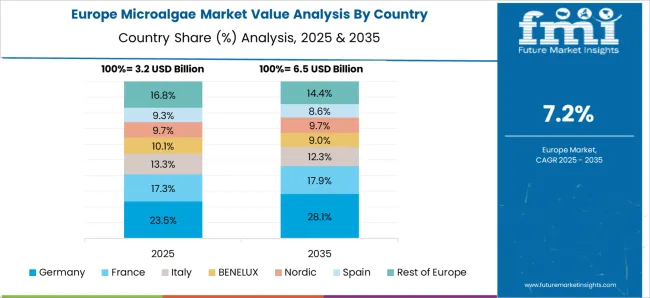
The sales of microalgae in Germany are projected to witness a CAGR of 4.8% from 2025 to 2035. The country is at the forefront of clean energy policies and algae-derived biomass utilization. There is increased usage in animal feed, bioplastics, and dietary supplements. Advanced cultivation systems such as closed-loop photobioreactors are increasingly deployed to meet industrial demands and strict EU quality standards.
The revenue from microalgae in France is expected to grow at a CAGR of 5.2% from 2025 to 2035. The country’s robust food and beverage sector is integrating microalgae in dairy alternatives, sauces, and health snacks. France also leads in incorporating algae into organic fertilizers and biostimulants to support regenerative agriculture. Public-private partnerships are supporting innovation in cultivation in Brittany and other regions.
The microalgae market in Japan is projected to record a CAGR of 5.1% from 2025 to 2035. The country emphasizes novel photobioreactor applications in wastewater treatment and energy systems. Microalgae are used in dietary supplements, fermented foods, and skincare. The scarcity of fossil fuel resources has prompted Japan to develop algae-based alternatives, while the government supports algae R&D through innovation grants.
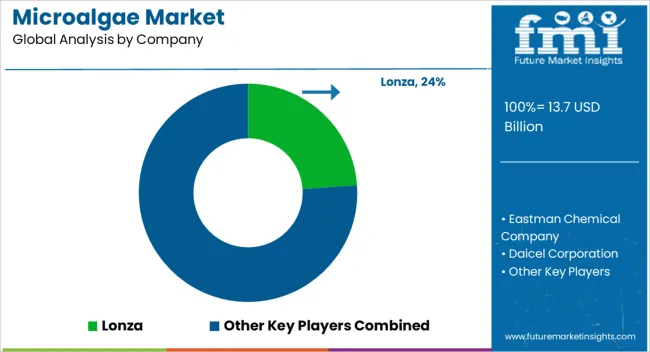
The microalgae market is moderately fragmented, with several established and emerging players competing across diverse application segments. Key suppliers such as Lonza, Eastman Chemical Company, Mitsubishi Chemical Co., Ltd., and Daicel Corporation are enhancing their competitive edge through innovation in microalgae-derived nutraceuticals, cosmetics, and sustainable fuels. These companies operate globally, often leveraging region-specific R&D centers and supply chain advantages to meet the growing demand for algae-based functional ingredients.
Top players are competing based on pricing, quality, and product differentiation, particularly in the rapidly growing health and medical, food and beverage, and personal care markets. Companies are also focusing on sustainable production models, algae strain optimization, and clean-label certification.
Strategic partnerships and expansion into high-growth markets such as Asia-Pacific and North America are central to their growth strategies. Lonza and Eastman Chemical Company have notably increased investments in microalgae for pharmaceutical-grade compounds, while firms like Jubilant Life Sciences Ltd. are targeting applications in bioenergy and animal nutrition.
Recent Microalgae Industry News
| Report Attributes | Details |
|---|---|
| Current Total Market Size (2025) | USD 13.7 billion |
| Projected Market Size (2035) | USD 29.6 billion |
| CAGR (2025 to 2035) | 8.0% |
| Base Year for Estimation | 2024 |
| Historical Period | 2020-2024 |
| Projections Period | 2025-2035 |
| Market Analysis Parameters | Revenue in USD billions/Volume in Kilotons |
| By Species Type | Spirulina, Chlorella, Dunaliella, Haematococcus, Crypthecodinium, Schizochytrium, Euglena, Nannochloropsis, Phaedactylum, Others (Ankistrodesmus, Tetraselmis, Isochrysis) |
| By Source | Marine Water, Fresh Water |
| By Application | Food and Beverages Sector, Health and Medical Sector, Animal Feed Sector, Pet Food Sector, Cosmetics and Personal Care Sector, Fertilizers Sector |
| Regions Covered | North America, Latin America, Europe, Middle East & Africa, Asia Pacific |
| Countries Covered | United States, Canada, United Kingdom, Germany, France, China, Japan, South Korea, Brazil, Australia |
| Key Players | Lonza, Eastman Chemical Company, Daicel Corporation, Laxmi Organic Industries Ltd., Mitsubishi Chemical Co., Ltd., Zhangjiagang Hope Chemicals Co., Ltd., Nantong Acetic Acid Chemical Co., Ltd., Ningbo Wanglong Technology Co., Jubilant Life Sciences Ltd., Toronto Research Chemicals |
| Additional Attributes | Dollar sales by value, segment-wise market share analysis, and country-wise market breakdown |
The global microalgae market is estimated to be valued at USD 13.7 billion in 2025.
The market size for the microalgae market is projected to reach USD 29.6 billion by 2035.
The microalgae market is expected to grow at a 8.0% CAGR between 2025 and 2035.
The key product types in microalgae market are spirulina, chlorella, dunaliella, haematococcus, crypthecodinium, schizochytrium, euglena, nannochloropsis, phaedactylum and others.
In terms of source, marine water segment to command 55.3% share in the microalgae market in 2025.






Our Research Products

The "Full Research Suite" delivers actionable market intel, deep dives on markets or technologies, so clients act faster, cut risk, and unlock growth.

The Leaderboard benchmarks and ranks top vendors, classifying them as Established Leaders, Leading Challengers, or Disruptors & Challengers.

Locates where complements amplify value and substitutes erode it, forecasting net impact by horizon

We deliver granular, decision-grade intel: market sizing, 5-year forecasts, pricing, adoption, usage, revenue, and operational KPIs—plus competitor tracking, regulation, and value chains—across 60 countries broadly.

Spot the shifts before they hit your P&L. We track inflection points, adoption curves, pricing moves, and ecosystem plays to show where demand is heading, why it is changing, and what to do next across high-growth markets and disruptive tech

Real-time reads of user behavior. We track shifting priorities, perceptions of today’s and next-gen services, and provider experience, then pace how fast tech moves from trial to adoption, blending buyer, consumer, and channel inputs with social signals (#WhySwitch, #UX).

Partner with our analyst team to build a custom report designed around your business priorities. From analysing market trends to assessing competitors or crafting bespoke datasets, we tailor insights to your needs.
Supplier Intelligence
Discovery & Profiling
Capacity & Footprint
Performance & Risk
Compliance & Governance
Commercial Readiness
Who Supplies Whom
Scorecards & Shortlists
Playbooks & Docs
Category Intelligence
Definition & Scope
Demand & Use Cases
Cost Drivers
Market Structure
Supply Chain Map
Trade & Policy
Operating Norms
Deliverables
Buyer Intelligence
Account Basics
Spend & Scope
Procurement Model
Vendor Requirements
Terms & Policies
Entry Strategy
Pain Points & Triggers
Outputs
Pricing Analysis
Benchmarks
Trends
Should-Cost
Indexation
Landed Cost
Commercial Terms
Deliverables
Brand Analysis
Positioning & Value Prop
Share & Presence
Customer Evidence
Go-to-Market
Digital & Reputation
Compliance & Trust
KPIs & Gaps
Outputs
Full Research Suite comprises of:
Market outlook & trends analysis
Interviews & case studies
Strategic recommendations
Vendor profiles & capabilities analysis
5-year forecasts
8 regions and 60+ country-level data splits
Market segment data splits
12 months of continuous data updates
DELIVERED AS:
PDF EXCEL ONLINE
Microalgae in Fertilizers Market Analysis - Size, Share, and Forecast 2025 to 2035
Microalgae-Based Aquafeed Market – Growth & Sustainable Feed Trends
Microalgae DHA Market
Pet Food Microalgae Market Insights - Nutritional Benefits & Growth 2025 to 2035
Freshwater Microalgae Market Analysis by Strain type and End Use Application Through 2035
Animal Feeds Microalgae Market Size and Share Forecast Outlook 2025 to 2035
Food and Beverage Microalgae Market - Demand & Future Innovations 2025 to 2035
Health and Medical Microalgae Market – Innovations & Industry Trends 2025 to 2035
Personal Care and Cosmetics Microalgae Market - Beauty & Skincare Trends 2025 to 2035

Thank you!
You will receive an email from our Business Development Manager. Please be sure to check your SPAM/JUNK folder too.
Chat With
MaRIA